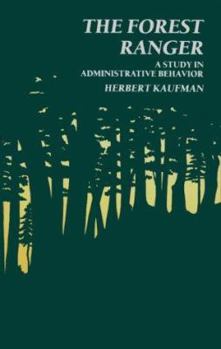The Forest Ranger: A Study in Administrative Behavior
Select Format
Select Condition 
Book Overview
It is the rare book that remains in print for nearly fifty years, earning wide acclaim as a classic. The Forest Ranger has been essential reading for generations of professionals and scholars in... This description may be from another edition of this product.
Format:Paperback
Language:English
ISBN:0801803284
ISBN13:9780801803284
Release Date:January 1967
Publisher:Johns Hopkins University Press
Length:259 Pages
Weight:0.75 lbs.
Dimensions:0.8" x 5.2" x 8.2"
Customer Reviews
1 rating
A Case Study in the Golden Age of PA
Published by Thriftbooks.com User , 22 years ago
First published in 1960, The Forest Ranger is an impressive study of the United States Forest Service. In the book, Kaufman (1960/1967) case studies the behavior of district rangers in the Forest Service and endeavors for an answer to the question of how policies formulated by policy executives are realized into integrated action by a service whose field personnel operate under varied conditions. "Even in agencies with simple, routine responsibilities, welding the behavior of field personnel into integral patterns is often a trying experience" (p. 25). In an agency which is as much dispersed and heterogeneous as the Forest Service, is it possible to secure an integrated and coherent policy implementation across a great number of the districts? If you believe it is impossible, I strongly recommend you to have a look at The Forest Ranger by Herbert Kaufman. The readers who are familiar with Herbert Simon should remember his masterpiece "Administrative Behavior" in which the author at "theoretical level" demonstrated what takes for the leaders of administrative agencies to direct, manage, and run largely staffed and complex organizations. Simon (1947/1997) spent his intellectual energy for an inquiry into the decision-making process, and knitted his theory around it by developing an impressive understanding that helped the readers to sense that "integrated policy action" depends on the degree that the leaders can control the "environment" of decision-making so that every individual employee in the organization adjusts his/her decisions to common objectives fashioned by policy makers. Organization design, implicitly, stood out as prerequisite for integrated policy action, with "organization design" serving to bring decision premises and necessary data to the attention and use of decision-makers. Herbert Kaufman (1960/1967), in The Forest Ranger, demonstrates vividly how once a "theory" becomes a reality in the case of the United States Forest Service.I would not want to summarize the case study with the fear that I am likely to discolor a vivid masterpiece. Suffice to say that at present times in which orthodox public administration theory is being transformed by a new body of knowledge and skills, this case study should present (sometimes poignantly) the assumptions, ideals, weaknesses and strengths of orthodox public administration in its "golden age" that has reached a final stage in our contemporary times. This classic book is organized into seven major chapters. The first chapter gives a summary of research design, data collection and analysis procedures, and the plan of the book. The second chapter makes the reader familiar with the size and complexity of the Forest Service with accompanying challenges to integrated policy action. The third chapter elucidates the challenges to unity that emanate from internal communication problems, the potential for field officers to be captured by local populations, personal preferences of field officers, and





